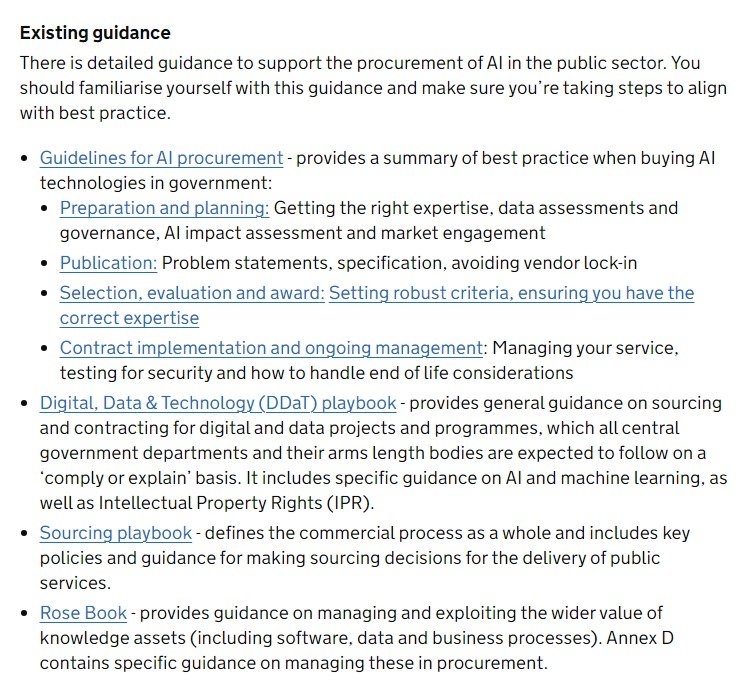The UK Government has recently published its official response (the ‘response’) to the public consultation of March 2023 on its ‘pro-innovation approach’ to AI regulation (for an initial discussion, see here). The response shows very little movement from the original approach and proposals and, despite claiming that significant developments have already taken place, it mainly provides a governmental self-congratulatory narrative and limited high-level details of a regulatory architecture still very much ‘under construction’. The publication of the response was coupled with that of Initial Guidance for Regulators on Implementing the UK’s AI Regulatory Principles (Feb 2024), which I will comment in a subsequent post.
A section of particular interest in the response refers to ‘Ensuring AI best practice in the public sector’ (at 21-22), which makes direct reference to the use of public procurement and the exercise of public sector buying power as a regulatory lever.
This section describes some measures being put in place or planned to seize ‘the opportunities presented by AI to deliver better public services including health, education, and transport’, such as:
‘tripling the number of technical AI engineers and developers within the Cabinet Office to create a new AI Incubator for the government’ (para 41).
This is an interesting commitment to building in-house capability. It would however be interesting to know whether these are new or reassigned roles, as well as how the process of recruitment and retention is faring, given the massive difficulties evidenced in the recent analysis by the National Audit Office, Digital transformation in government: addressing the barriers to efficiency (10 Mar 2023, HC 2022-23, 1171).‘The government is also using the procurement power of the public sector to drive responsible and safe AI innovation. The Central Digital and Data Office (CDDO) has published guidance on the procurement and use of generative AI for the UK government. Later this year, DSIT will launch the AI Management Essentials scheme, setting a minimum good practice standard for companies selling AI products and services. We will consult on introducing this as a mandatory requirement for public sector procurement, using purchasing power to drive responsible innovation in the broader economy’ (para 43).
This is also an interesting aspiration, for several reasons. First, the GenAI guidance is very generic and solely highlights pre-existing (also very generic) guidance on how to carry out procurement of AI (see screenshot below). This can hardly be seen as a meaningful development of the existing regulatory framework. Second, the announcement of an ‘AI Management Essentials’ scheme seems to be mirrored on the ‘Cyber Essentials’ scheme in the area of cyber security, despite significant differences and the much higher level of complexity that can be expected from an ‘all-encompassing’ scheme for the management of the myriad risks generated by the deployment of AI.
Screenshot of the webpage https://www.gov.uk/government/publications/generative-ai-framework-for-hmg/generative-ai-framework-for-hmg-html (accessed 22 February 2024), where this information is available in accessible format.
‘This builds on the Algorithmic Transparency Recording Standard (ATRS), which established a standardised way for public sector organisations to proactively publish information about how and why they are using algorithmic methods in decision-making. Following a successful pilot of the standard, and publication of an approved cross-government version last year, we will now be making use of the ATRS a requirement for all government departments and plan to expand this across the broader public sector over time’ (para 44).
This is also interesting in that the ‘success’ attributed to the development of the ATRS is very clearly undermined by the almost absolute lack of use other than in relation to the pilot projects (see screenshot below). It is also interesting that the ATRS allows public sector AI deployers to fill in but not publish the relevant documents, as a form of self-reflective/evaluative exercise. I wonder how many publications we will see in the coming months, even if ‘use of the ATRS’ becomes a requirement.
Screenshot of the list of published transparency disclosures at Algorithmic Transparency Reports - GOV.UK (www.gov.uk) (accessed 22 February 2024), where this information is available in accessible format.
Overall, I think the response to the ‘pro-innovation’ AI regulation consultation does little to back up the high expectations being placed in public procurement as a mechanism of regulation by contract. I will update the analysis in this UK-focused paper on the use of procurement to regulate public sector AI use before final publication, but there will be little change. The broader analysis in my recent monograph also remains applicable (phew): Digital Technologies and Public Procurement. Gatekeeping and experimentation in digital public governance (OUP 2024).



